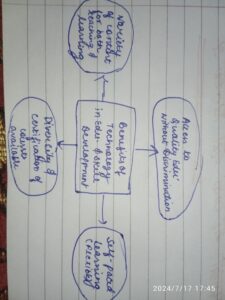Mathematics holds a very important place in education for several reasons: Critical Thinking: It improves problem-solving skills and logical reasoning, which are essential in everyday decision-making. Foundational Knowledge: Mathematics is fundamental to understanding other subjects such as science,Read more
Mathematics holds a very important place in education for several reasons:
- Critical Thinking: It improves problem-solving skills and logical reasoning, which are essential in everyday decision-making.
- Foundational Knowledge: Mathematics is fundamental to understanding other subjects such as science, engineering, economics, and technology.
- Career Opportunities: Proficiency in mathematics opens doors to various careers in fields like data analysis, finance, computer science, pilot and engineering.
- Daily Applications: Math is used in everyday activities, from budgeting and shopping to cooking and home repairs.
- Cognitive Development: It improves cognitive abilities, including memory, attention, and the ability to think abstractly.
- Innovation and Technology: Mathematics is crucial for advancements in technology and innovation, it is driving progress in numerous industries.
- Global Competitiveness: Strong math skills are essential for competing in a global economy, as technological and scientific expertise is highly valued in today’s world.
Overall, mathematics is more than just a subject; it is a tool that equips individuals with the skills necessary for personal and professional success.
See less

Major Education Policies: 1. Curriculum and Standards: • USA: The curriculum is largely determined by individual states and local school districts, leading to significant variations. There are national guidelines like the Common Core Standards for mathematics and English language arts, but adoptionRead more
Major Education Policies:
1. Curriculum and Standards:
• USA: The curriculum is largely determined by individual states and local school districts, leading to significant variations. There are national guidelines like the Common Core Standards for mathematics and English language arts, but adoption is optional.
• South Korea: The Ministry of Education sets a national curriculum that is uniformly followed by all schools. There is a strong emphasis on STEM subjects and English language proficiency.
2. School Funding:
• USA: Funding comes from federal, state, and local sources, with a significant portion from local property taxes. This often results in disparities in resources between wealthy and poorer districts.
• South Korea: Education is primarily funded by the central government, which helps ensure more uniformity in resource allocation across different regions.
3. Standardized Testing:
• USA: Students undergo various standardized tests like the SAT/ACT for college admissions and state assessments for K-12 accountability.
• South Korea: The College Scholastic Ability Test (CSAT) is a highly competitive national exam that significantly influences university admissions. There are also frequent assessments throughout K-12 education to monitor progress.
4. Teacher Qualifications and Training:
• USA: Teachers must obtain state certification, which typically requires a bachelor’s degree in education, passing relevant exams, and completing continuing education credits. Teacher preparation programs vary widely.
•South Korea: Teachers are highly respected and undergo rigorous training, often requiring a four-year degree from a teacher’s college, passing a national exam, and completing a mandatory induction period.
5. Class Size and School Hours:
• USA: Class sizes vary widely, with an average student-to-teacher ratio around 16:1. School hours typically range from 6 to 7 hours per day.
•South Korea: Class sizes tend to be larger, averaging around 23 students per teacher. School hours are long, with a typical day running from 8 AM to 4 PM, often followed by after-school tutoring sessions (hagwons).
6.Higher Education:
• USA: Higher education is diverse, with a mix of public and private institutions, community colleges, and universities. The cost of tuition can be high, leading to significant student debt.
•South Korea: Higher education is also highly competitive, with prestigious universities like Seoul National University, KAIST, and POSTECH. Tuition is generally lower compared to the USA, and the government provides various scholarships and financial aid.
7.Focus on Education:
•USA: There is a growing emphasis on holistic education, including extracurricular activities, arts, and physical education. There is also a focus on addressing educational disparities and promoting inclusivity.
•South Korea: Education is highly valued, with intense pressure on students to succeed academically. There is a strong societal expectation for high academic achievement, which often leads to high levels of stress among students.
Key Differences:
•Curriculum Control: The USA has decentralized control with significant local variation, whereas South Korea has a centralized, uniform curriculum.
•Funding Sources: The USA relies heavily on local funding, leading to disparities, while South Korea’s centralized funding aims for more uniform resource distribution.
•Testing Emphasis: Both countries emphasize standardized testing, but South Korea’s CSAT has a more profound impact on students’ futures compared to any single test in the USA.
•Teacher Training: South Korean teachers undergo more rigorous and standardized training compared to the more variable requirements in the USA.
• Class Sizes and School Hours: South Korean schools generally have larger class sizes and longer school hours, including extensive after-school tutoring.
•Higher Education: The cost and funding structure of higher education differ significantly, with South Korean students facing less financial burden compared to their American counterparts.
•Educational Pressure: The societal and parental pressure on students to perform well academically is more intense in South Korea than in the USA.
See lessThese differences reflect broader cultural, societal, and policy approaches to education in the two countries.